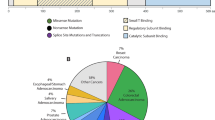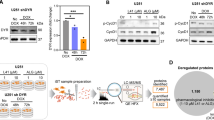Abstract
Activating BRAF mutations that deregulate the mitogen-activated protein kinase (MAPK) pathway commonly occur in cancer. BRAFV600E induces centrosome amplification and spindle abnormalities that result in aneuploidy. We find modification of Mps1 is critical for contributing to centrosome amplification and chromosome instability induced by BRAFV600E. Phosphorylation of Mps1 at residue S281 induced by BRAFV600E stabilizes Mps1 protein by preventing its ubiquitination by APC/C and subsequent degradation, allowing the non-degraded protein to accumulate at centrosomes. Cells in which endogenous Mps1 was replaced with a phospho-mimetic Mps1 mutant are viable but amplify centrosomes and missegregate chromosomes frequently. Importantly, analysis of tumor micro arrays revealed that phospho-MAPK and S281-phosphorylated Mps1 were highly correlated in human melanoma tissues, implying that MAPK contributes to defects in the degradation of Mps1 in situ. We propose that continuously activated BRAFV600E signaling may be a possible mechanism for the deregulation of Mps1 stability and kinase activity in human tumors, and that persistent phosphorylation of Mps1 through BRAFV600E signaling is a key event in disrupting the control of centrosome duplication and chromosome stability that may contribute to tumorigenesis. Our findings raise the possibility that targeting the oncogenic BRAF and S281-phosphorylated Mps1, especially when used in combination could potentially provide great therapeutic opportunities for cancer treatment.
This is a preview of subscription content, access via your institution
Access options
Subscribe to this journal
Receive 50 print issues and online access
$259.00 per year
only $5.18 per issue
Buy this article
- Purchase on Springer Link
- Instant access to full article PDF
Prices may be subject to local taxes which are calculated during checkout






Similar content being viewed by others
References
Wan PT, Garnett MJ, Roe SM, Lee S, Niculescu-Duvaz D, Good VM et al. Mechanism of activation of the RAF-MAPK signaling pathway by oncogenic mutations of B-RAF. Cell 2004; 116: 855–867.
Karreth FA, Tuveson DA . Modelling oncogenic Ras/Raf signalling in the mouse. Curr Opin Genet Dev 2009; 19: 4–11.
Davies H, Bignell GR, Cox C, Stephens P, Edkins S, Clegg S et al. Mutations of the BRAF gene in human cancer. Nature 2002; 417: 949–954.
Dhomen N, Reis-Filho JS, da Rocha DS, Hayward R, Savage K, Delmas V et al. Oncogenic Braf induces melanocyte senescence and melanoma in mice. Cancer Cell 2009; 15: 294–303.
Gray-Schopfer V, Wellbrock C, Marais R . Melanoma biology and new targeted therapy. Nature 2007; 445: 851–857.
Flaherty KT, Puzanov I, Kim KB, Ribas A, McArthur GA, Sosman JA et al. Inhibition of mutated, activated BRAF in metastatic melanoma. N Engl J Med 2010; 363: 809–819.
Bollag G, Hirth P, Tsai J, Zhang J, Ibrahim PN, Cho H et al. Clinical efficacy of a RAF inhibitor needs broad target blockade in BRAF-mutant melanoma. Nature 2010; 467: 596–599.
Haering CH, Farcas AM, Arumugam P, Metson J, Nasmyth K . The cohesin ring concatenates sister DNA molecules. Nature 2008; 454: 297–301.
Cui Y, Borysova MK, Johnson JO, Guadagno TM . Oncogenic B-RafV600E induces spindle abnormalities, supernumerary centrosomes, an aneuploidy in human melanocytic cells. Cancer Res 2010; 70: 675–684.
Compton DA . Mechanisms of aneuploidy. Curr Opin Cell Biol 2011; 23: 109–113.
Acilan C, Saunders WS . A tale of too many centrosomes. Cell 2008; 134: 572–575.
Fukasawa K . Oncogenes and tumour suppressors take on centrosomes. Nat Rev Cancer 2007; 7: 911–924.
Kanai M, Ma Z, Izumi H, Kim SH, Mattison CP, Winey M et al. Physical and functional interaction between mortalin and Mps1 kinase. Genes Cells 2007; 12: 797–810.
Liu ST, Chan GK, Hittle JC, Fujii G, Lees E, Yen TJ . Human MPS1 kinase is required for mitotic arrest induced by the loss of CENP-E from kinetochores. Mol Biol Cell 2003; 14: 1638–1651.
Kasbek C, Yang CH, Fisk HA . Antizyme restrains centrosome amplification by regulating the accumulation of mps1 at centrosomes. Mol Biol Cell 2010; 21: 3878–3889.
Fisk HA, Mattison CP, Winey M . Human Mps1 protein kinase is required for centrosome duplication and normal mitotic progression. Proc Natl Acad Sci USA 2003; 100: 14875–14880.
Stucke VM, Sillje HH, Arnaud L, Nigg EA . Human Mps1 kinase is required for the spindle assembly checkpoint but not for centrosome duplication. EMBO J 2002; 21: 1723–1732.
Tighe A, Staples O, Taylor S . Mps1 kinase activity restrains anaphase during an unperturbed mitosis and targets Mad2 to kinetochores. J Cell Biol 2008; 181: 893–901.
Hewitt L, Tighe A, Santaguida S, White AM, Jones CD, Musacchio A et al. Sustained Mps1 activity is required in mitosis to recruit O-Mad2 to the Mad1-C-Mad2 core complex. J Cell Biol 2010; 190: 25–34.
Santaguida S, Tighe A, D’Alise AM, Taylor SS, Musacchio A . Dissecting the role of MPS1 in chromosome biorientation and the spindle checkpoint through the small molecule inhibitor reversine. J Cell Biol 2010; 190: 73–87.
Tyler RK, Chu ML, Johnson H, McKenzie EA, Gaskell SJ, Eyers PA . Phosphoregulation of human Mps1 kinase. Biochem J 2009; 417: 173–181.
Mattison CP, Old WM, Steiner E, Huneycutt BJ, Resing KA, Ahn NG et al. Mps1 activation loop autophosphorylation enhances kinase activity. J Biol Chem 2007; 282: 30553–30561.
Kasbek C, Yang CH, Yusof AM, Chapman HM, Winey M, Fisk HA . Preventing the degradation of mps1 at centrosomes is sufficient to cause centrosome reduplication in human cells. Mol Biol Cell 2007; 18: 4457–4469.
Kasbek C, Yang CH, Fisk HA . Mps1 as a link between centrosomes and genomic instability. Environ Mol Mutagen 2009; 50: 654–665.
Cui Y, Cheng X, Zhang C, Zhang Y, Li S, Wang C et al. Degradation of the human mitotic checkpoint kinase Mps1 is cell cycle-regulated by APC-cCdc20 and APC-cCdh1 ubiquitin ligases. J Biol Chem 2010; 285: 32988–32998.
Yang CH, Kasbek C, Majumder S, Mohd Yusof A, Fisk HA . Mps1 phosphorylation sites regulate the function of Centrin 2 in centriole assembly. Mol Biol Cell 2010; 21: 4361–4372.
Cui Y, Guadagno TM . B-RafV600E signaling deregulates the mitotic spindle checkpoint through stabilizing Mps1 levels in melanoma cells. Oncogene 2008; 27: 3122–3133.
Kang J, Chen Y, Zhao Y, Yu H . Autophosphorylation-dependent activation of human Mps1 is required for the spindle checkpoint. Proc Natl Acad Sci USA 2007; 104: 20232–20237.
Palframan WJ, Meehi JB, Jaspersen SL, Winey M, Murray AW . Anaphase inactivation of the spindle checkpoint. Science 2006; 313: 680–684.
Jelluma N, Brenkman AB, van den Broek NJ, Cruijsen CW, van Osch MH, Lens SM et al. Mps1 phosphorylates Borealin to control Aurora B activity and chromosome alignment. Cell 2008; 132: 233–246.
Zhao Y, Chen RH . Mps1 phosphorylation by MAP kinase is required for kinetochore localization of spindle-checkpoint proteins. Curr Biol 2006; 16: 1764–1769.
Pike AN, Fisk HA . Centriole assembly and the role of Mps1: defensible or dispensable? Cell Div 2011; 6: 9.
Andersen JS, Wilkinson CJ, Mayor T, Mortensen P, Nigg EA, Mann M . Proteomic characterization of the human centrosome by protein correlation profiling. Nature 2003; 426: 570–574.
Fabunmi RP, Wigley WC, Thomas PJ, DeMartino GN . Activity and regulation of the centrosome-associated proteasome. J Biol Chem 2000; 275: 409–413.
Nakayama K, Nagahama H, Minamishima YA, Matsumoto M, Nakamichi I, Kitagawa K et al. Targeted disruption of Skp2 results in accumulation of cyclin E and p27(Kip1), polyploidy and centrosome overduplication. EMBO J 2000; 19: 2069–2081.
Tsou MF, Stearns T . Mechanism limiting centrosome duplication to once per cell cycle. Nature 2006; 442: 947–951.
Wojcik EJ, Glover DM, Hays TS . The SCF ubiquitin ligase protein slimb regulates centrosome duplication in Drosophila. Curr Biol 2000; 10: 1131–1134.
Mangold U, Hayakawa H, Coughlin M, Munger K, Zetter BR . Antizyme, a mediator of ubiquitin-independent proteasomal degradation and its inhibitor localize to centrosomes and modulate centriole amplification. Oncogene 2008; 27: 604–613.
Janssen A, Kops GJ, Medema RH . Elevating the frequency of chromosome mis-segregation as a strategy to kill tumor cells. Proc Nat Acad Sci USA 2009; 106: 19108–19113.
Acknowledgements
We thank Kenji Fukasawa (H Lee Moffitt Cancer Center) for critical reading of this article. This work was supported by the Program for New Century Excellent Talents University of China (Grant NCET-10-0872), National Nature Science Foundation of China (Grant 30872932 & 30971518), Scientific Research Foundation for the Returned Overseas Chinese Scholars, State Education Ministry (Grant 2009-8), Shanxi Province Foundation for Returness (2008-49), Trainee Development Award from Bankhead Coley Program (Grant 30-15066-02-07) to YC and National Nature Science Foundation of China (Grant 81071625), Program for the Top Young Academic Leaders of Higher Learning Institutions of Shanxi to XC.
Author information
Authors and Affiliations
Corresponding author
Ethics declarations
Competing interests
The authors declare no conflict of interest.
Additional information
Supplementary Information accompanies the paper on the Oncogene website
Supplementary information
Rights and permissions
About this article
Cite this article
Liu, J., Cheng, X., Zhang, Y. et al. Phosphorylation of Mps1 by BRAFV600E prevents Mps1 degradation and contributes to chromosome instability in melanoma. Oncogene 32, 713–723 (2013). https://doi.org/10.1038/onc.2012.94
Received:
Revised:
Accepted:
Published:
Issue Date:
DOI: https://doi.org/10.1038/onc.2012.94
Keywords
This article is cited by
-
Inactivation of the Hippo tumor suppressor pathway promotes melanoma
Nature Communications (2022)
-
Oncogenic BRAF induces whole-genome doubling through suppression of cytokinesis
Nature Communications (2022)
-
Gene expression profiling of anti-CTLA4-treated metastatic melanoma in patients with treatment-induced autoimmunity
Laboratory Investigation (2017)
-
Genomic analyses reveal FAM84B and the NOTCH pathway are associated with the progression of esophageal squamous cell carcinoma
GigaScience (2016)



